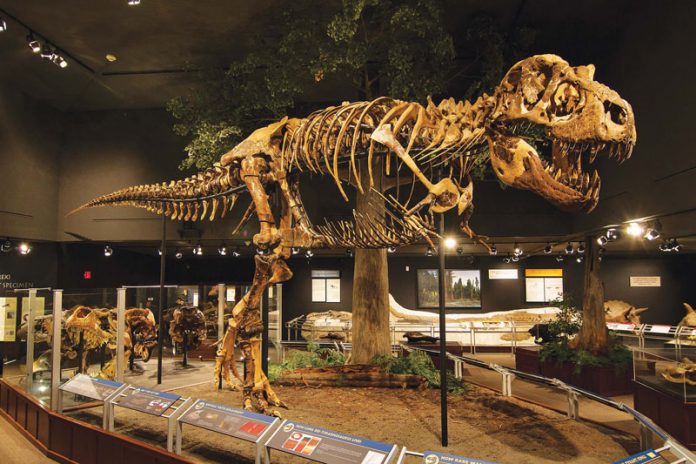
Exploring the Montana Dinosaur Trail, you can almost envision dinosaurs roaming the arid, expansive prairies and badlands of Central and Eastern Montana. This entire region provides remarkable opportunities for amateur paleontologists to explore this fascinating realm while they get their hands in the dirt. While in Montana, it’s also fun to rockhound for Montana sapphires and explore the history of copper mining in Butte.
Montana was a vastly different landscape than it is today. “It was warmer than it is now and there doesn’t appear to be evidence of frozen polar ice caps,” noted Eric Metz, paleontology collections manager of the Museum of the Rockies in Bozeman. The Western Interior Seaway stretched from the Rocky Mountains east to nearly Minnesota, with a humid landscape lush with ferns and gymnosperms, such as conifers and Ginkos.
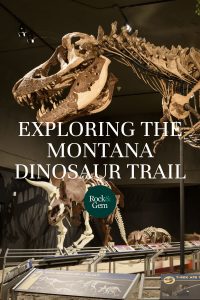
This vegetation fed herbivorous dinosaurs like the Maiasauras, Cerasinops, a relative of the Triceratops, and the 90-foot-long Apatosaurus. These species, as well as smaller animals, were often food for the iconic Tyrannosaurus Rex, the smaller Troodons, or the “raptor” Deinonychus during the Jurassic and Cretaceous Periods.
“We have a lot of evidence of early birds. They had teeth, which was cool,” said Metz who noted that there were also flying reptiles, which were not dinosaurs, and the Pterosaur was the largest creature that ever flew. “And you still had different species of lizards and frogs.”
While we don’t often envision it, Metz points out that there were three groups of mammals during this time, including the placentals, marsupials, and multituberculates, which had rows of cusped, interlocking teeth. These went extinct after the Cretaceous period for reasons unknown. And besides the land-dwelling animals, the inland sea teamed with life including the Plesiosaur, Mosasaur, and large marine turtles.
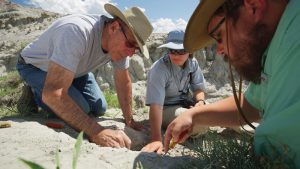
Digging Up The Past
While dinosaurs roamed most of North America, Montana is special when it comes to finding evidence of their lives. Metz said, ”To have dinosaur fossils present you have to have rocks of the right age and you don’t want to have strip malls and houses on top of it. Here we have large tracts of state, federal and private land where the rock is exposed.”
“We have Jurassic and Cretaceous exposures,” he said. “The Morrison Formation is one of the oldest rocks we have fossils from and it is approximately 156 million years old.”
With this foundation, there is a long history of important fossil finds in the state beginning as far back as the mid-1850s when the naturalist Ferdinand Hayden, who later led a geological survey into what is now Yellowstone National Park, discovered several species in what is now Upper Missouri Breaks National Monument. And in 1902, paleontologist Barnum Brown found the first “T-Rex” in the Hell Creek Formation.
More recently, finds changed the way we view dinosaurs. A generation ago, we were taught that dinosaurs were cold-blooded, slow-moving, lizard-like creatures with tails that dragged on the ground. Even the word dinosaur is derived from the Greek term “deinos” meaning terrible and “sauros” lizard.
In reality, Metz said, “They were agile, upright, and had different levels of temperature regulation.”
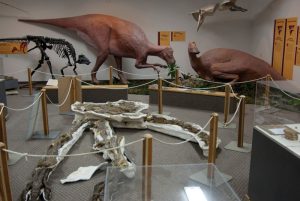
Photo courtesy Montana Dinosaur Trail
The Trexler’s Heritage
Discoveries, often by untrained aficionados, significantly shifted the scientific perspective. When Marion (Trexler) Brandvold, owner of the Trex Agate Shop in Bynum (what locals call “The Rock Shop”), found the remains of baby dinosaurs in 1978 while exploring the ranch land owned by James and Marian Peebles, the unique find turned paleontology on its head. For the first time, scientists recognized that dinosaurs cared for their young.
Brandvold contacted paleontologist Jack Horner, most recently well-known as the scientific advisor for the Jurassic Park movies, who further investigated the site, eventually finding a nest of dinosaur eggs of the newly named Maiasaura peeblesorum on what is now called Egg Mountain.
“We now know they are warm-blooded, very social and lived in herds,” explained Stacia Coverdell, assistant director of the Montana Dinosaur Center in Bynum, which came into being because of the Trexler family’s passion for dinosaurs.
“Our founder Dave Trexler, grew up out here on the ranch. When he was a teenager he found a dinosaur spine and wanted to know what he found,” she said. So he and his mother, Marion Brandvold, took a tour of the state to see what other museums offered as far as displaying their finds. The only skeleton they found was in the basement of the high school in Eklalaka. Upon their return, they turned the back half of the rock shop into a museum.
Hands-On Opportunities
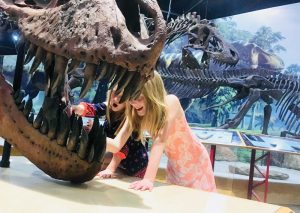
Photo courtesy of Montana Dinosaur Trail
With this fascination from his youth, Dave Trexler obtained his Masters in paleontology. He opened the Dinosaur Center in 1995 with the philosophy that science was for everyone. He offered hands-on digs for visitors, as well as an opportunity to see what is found in this area.
“All the fossils were used for scientific research,” Coverdell noted. “It’s basically a museum in reverse. We collect things together and then display them.”
From early May to the end of September, visitors can tour the museum, which is staffed with knowledgeable and friendly employees all with field experience. And from Memorial Day into September, half and full-day expeditions give guests real-life field experience in excavating fossils. The half-day outings are perfect for families with young children as it’s more of a “show and tell” adventure where they are not in the hot sun and weather for the entire day. The full-day digs put dinosaur fans into the nitty gritty of paleontological study.
“I’ve had four-year-olds and I’ve had 82-year-olds out,” said Coverdell. “We’ve dug in all sorts of sites. Our current dig site is by Augusta. We call it ‘The Graveyard.’ It is a 300-foot long line of bones dug in a trench.” There are at least four species of dinosaurs within the area, and Coverdell describes it as a smorgasbord of what is found in the Two Medicine area.
Forging a Dinosaur Trail
The Montana Dinosaur Center is just one example of the world-class dinosaur exhibitions and opportunities found throughout the state. The Montana Dinosaur Trail is a path through this ancient history and a way for dinosaur enthusiasts to learn and experience as much as possible.
“We currently have 14 facilities on the trail,” explained Victor Baornberg, also known as Maia Saurus, who is the coordinator of the Montana Dinosaur Trail. “Each of these facilities has locally sourced dinosaurs.”
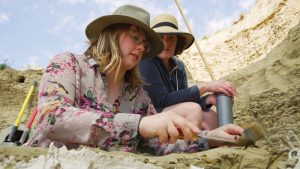
Photo courtesy of Montana Dinosaur Trail
The Montana Dinosaur Trail Takes Shape
The idea for the Dino Trail was generated by the community of Malta as a way to bring more people to their area. In 1994, Bjornberg said, “Amateur paleontologists found fully articulated dinosaur skeletons that had apparently died in a river and were covered with the sandbar.”
One of the finds included “Elvis” (named because they found its hip first), a nearly complete Brachylophosaurus skeleton, along with Leonardo, which had about 90% of the skin still on its body and earned a place in the Guinness Book of World Records as the best-preserved dinosaur.
It makes sense that dinosaurs are a draw. “Malta is a long way from everywhere,” explained Bjornberg, “The thought was to join museums across Montana and join forces creating a necklace of attractions.”
The trail kicked off with the opening of the Fort Peck Interpretive Center in 2005. “Peck’s Rex,” the impressive T-Rex replica of the nearly complete skeleton that was found in this area, is the wow factor that greets visitors. This center is also a terrific place to see the display of the creatures that once swam in the warm waters of this region.
Every museum or center features something special. There is a replica of Leonardo at the Great Plains Dinosaur Museum and Field Station in Malta, although the fossil is loaned to The Children’s Museum of Indianapolis, Indiana. The museum also offers dinosaur digs and educational programs for kids and adults throughout the summer. This fieldwork is important not only from the visitor’s perspective but also as an integral aspect of dinosaur research.
“Montana is a really large state and no museum has the whole picture,” said Metz. “We can’t be there all at once. More eyes looking is good for the collective.”
Besides the Montana Dinosaur Center and the Great Plains Dinosaur Museum, the Carter Museum in Ekalaka offers hands-on projects, including the much-anticipated Dino Shindig held in July where paleontologists from around the world lead discussions and field trips, along with a weekend of fossil-centered projects.
Unique Characters Along the Way
Along with these memorable experiences, there is something for every level of dinosaur interest. The Depot Museum in Rudyard, along Hwy 2, adds a bit of humor to their exhibits featuring the Gryposaurus, (pronounced “gripe-a-saurus”), which was excavated from the local farm of Lila Redding. The saying on the welcome sign for Rudyard is: “596 nice people and 1 sorehead.” In this case, the Gryposaurus fits the role.
Montana’s largest state park, Makoshika State Park, is home to at least 10 different dinosaur species, including the bulk of the skeleton of the rare Thescelosaur. The Old Trail Museum in Choteau, which is roughly a half-hour from the Montana Dinosaur Center, features a life-size Maiasaura, along with other finds from the region. (There’s also an excellent ice cream shop in the complex.)
With so much to do and see, the Montana Dinosaur Trail created a passport where visitors receive a stamp for each visit. When the passport book is full, the reward is a gold seal in recognition of its completion and a t-shirt specifically designed for the program. “You can’t buy it,” says Bjornberg. “You have to earn it.”
This story about the Montana dinosaur trail appeared in Rock & Gem magazine. Click here to subscribe. Story by Amy Grisak.













